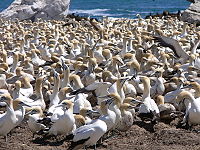Difference between revisions of "Gannet"
DavidB4-bot (Talk | contribs) (→top: clean up) |
|||
| (3 intermediate revisions by 2 users not shown) | |||
| Line 1: | Line 1: | ||
| + | {{Taxonomy | ||
| + | |name=Gannet | ||
| + | |image=Cape Gannet Lamberts Bay.JPG | ||
| + | |caption= | ||
| + | |domain=Eukaryota | ||
| + | |kingdom=Animalia | ||
| + | |subkingdom=Bilateria | ||
| + | |branch=Deuterostomia | ||
| + | |superphylum= | ||
| + | |phylum=Chordata | ||
| + | |subphylum=Vertebrata | ||
| + | |infraphylum=Gnathostomata | ||
| + | |microphylum= | ||
| + | |superdivision= | ||
| + | |division= | ||
| + | |subdivision= | ||
| + | |superclass=Tetrapoda | ||
| + | |class=Aves | ||
| + | |subclass=Neornithes | ||
| + | |infraclass=Neoaves | ||
| + | |superorder=Passerimorphae | ||
| + | |order=Pelecaniformes | ||
| + | |suborder=Ciconii | ||
| + | |infraorder=Ciconiides | ||
| + | |superfamily=Suloidea | ||
| + | |families= | ||
| + | |family=Sulidae | ||
| + | |subfamily= | ||
| + | |supertribe= | ||
| + | |tribe= | ||
| + | |subtribe= | ||
| + | |genera= | ||
| + | |genus=Morus | ||
| + | |subgenus= | ||
| + | |species=M. bassanus<br/>M. capensis<br/>M. serrator | ||
| + | |binomialname= | ||
| + | |syn= | ||
| + | |sub= | ||
| + | |alt= | ||
| + | |regionimg= | ||
| + | |pop= | ||
| + | |conservation= | ||
| + | }} | ||
The '''Gannet''' is a large seabird found in the [[Atlantic Ocean]]. It is three feet long and mostly white, with a yellow head and blue eyes; they can take four years to reach their full adult [[plumage]]. | The '''Gannet''' is a large seabird found in the [[Atlantic Ocean]]. It is three feet long and mostly white, with a yellow head and blue eyes; they can take four years to reach their full adult [[plumage]]. | ||
| − | Gannets have no nostrils, because God made them that way so they could dive into the sea from a great height, and this design protects their brains from damage from the pressure of the water.[http://elibrary.unm.edu/sora/Auk/v054n03/p0379-p0381.pdf] | + | Gannets have no nostrils, because God made them that way so they could dive into the sea from a great height, and this design protects their brains from damage from the pressure of the water.[http://elibrary.unm.edu/sora/Auk/v054n03/p0379-p0381.pdf] |
They nest in large groups on cliff ledges and small islands on the coasts of [[Europe]] and [[Canada]], although it is most common in the [[British Isles]]. They spend the winter at sea as far south as [[Mexico]], the [[Caribbean]] and [[Africa]]. They are also occasional visitors to the [[Great Lakes]]. In the tropics their closest relatives are the [[booby|boobies]]. | They nest in large groups on cliff ledges and small islands on the coasts of [[Europe]] and [[Canada]], although it is most common in the [[British Isles]]. They spend the winter at sea as far south as [[Mexico]], the [[Caribbean]] and [[Africa]]. They are also occasional visitors to the [[Great Lakes]]. In the tropics their closest relatives are the [[booby|boobies]]. | ||
| Line 7: | Line 50: | ||
Gannets catch [[fish]] by diving into the sea at them from a great height, and their legendary capacity to eat a lot of fish has made the gannet an emblem of [[greed]]. | Gannets catch [[fish]] by diving into the sea at them from a great height, and their legendary capacity to eat a lot of fish has made the gannet an emblem of [[greed]]. | ||
| − | [[Category: | + | [[Category:Birds]] |
Latest revision as of 23:01, June 24, 2016
| Gannet | |
|---|---|

| |
| Scientific classification | |
| Kingdom Information | |
| Domain | Eukaryota |
| Kingdom | Animalia |
| Subkingdom | Bilateria |
| Branch | Deuterostomia |
| Phylum Information | |
| Phylum | Chordata |
| Sub-phylum | Vertebrata |
| Infraphylum | Gnathostomata |
| Class Information | |
| Superclass | Tetrapoda |
| Class | Aves |
| Sub-class | Neornithes |
| Infra-class | Neoaves |
| Order Information | |
| Superorder | Passerimorphae |
| Order | Pelecaniformes |
| Sub-order | Ciconii |
| Infraorder | Ciconiides |
| Family Information | |
| Superfamily | Suloidea |
| Family | Sulidae |
| Genus Information | |
| Genus | Morus |
| Species Information | |
| Species | M. bassanus M. capensis M. serrator |
| Population statistics | |
The Gannet is a large seabird found in the Atlantic Ocean. It is three feet long and mostly white, with a yellow head and blue eyes; they can take four years to reach their full adult plumage.
Gannets have no nostrils, because God made them that way so they could dive into the sea from a great height, and this design protects their brains from damage from the pressure of the water.[1]
They nest in large groups on cliff ledges and small islands on the coasts of Europe and Canada, although it is most common in the British Isles. They spend the winter at sea as far south as Mexico, the Caribbean and Africa. They are also occasional visitors to the Great Lakes. In the tropics their closest relatives are the boobies.
Gannets catch fish by diving into the sea at them from a great height, and their legendary capacity to eat a lot of fish has made the gannet an emblem of greed.